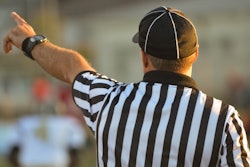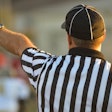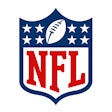Derek Boogaard's brain is handled with care these days. It resides with dozens of others at Boston University, donated to the Sports Legacy Institute so that it might be studied for signs of long-term damage.
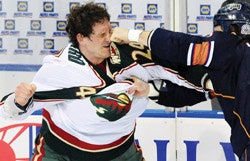
During six seasons as a National Hockey League enforcer, and an equal number of years of on-ice pugilistic apprenticeship prior to that, Boogaard's head took a beating. Following his death from an accidental alcohol and painkiller overdose a year ago this month, the 28-year-old's brain was found to contain defective tau proteins - the telltale evidence of chronic traumatic encephalopathy. Rick Rypien and Wade Belak, NHL players who likewise thrived with their fists, both died later last summer in apparent suicides.
The tragedies staggered the hockey world and shone perhaps the brightest spotlight yet on the sport's ugly sideshow. Some observers remain optimistic that - in a strictly figurative sense - the hockey enforcer is a dying breed. "The place for the typical enforcer as we knew it two decades ago, or even a decade ago, has all but gone out the window," says Dave Fischer, director of communications for USA Hockey, which is contemplating emergency legislation this summer that would increase penalties for fighting at its junior level as soon as next season.
But the bloodlust lives. Fans at Madison Square Garden rose to their feet as three fights broke out simultaneously one second into a March 19 NHL game between the New York Rangers and the New Jersey Devils. At least 10 players began swinging after the final horn ended an NHL game Feb. 29 between the Anaheim Ducks and Buffalo Sabres, prompting one fan to tweet, "That's why I love hockey. The refs stand around and let the players fight after time's up."
NHL commissioner Gary Bettman pointed last fall to healthy attendance figures as evidence that the league is giving fans what they want - welts and all. Certainly, the notion that fighting is not just entertaining, but an integral part of the game, has been pushed by hockey insiders for decades. "You've got to allow a definite reaction. If not, you're going to get sneaky, far more dangerous stuff," Don Cherry told author George Plimpton when Plimpton was training with Cherry's Boston Bruins in 1977, two years removed from Philadelphia's "Broad Street Bullies" having secured back-to-back Stanley Cup championships. "And besides, fighting, or the threat of it, plays an important tactical part in hockey. Intimidation. If you can make the other guy shy away from you and back down, because he knows you're more dominant, you've got a big advantage. It's the same in many sports."
Not quite. The hockey rink has long remained the lone domain where, at least at the professional and junior levels, fighting is not only tolerated, but expected. According to hockeyfights.com, at least one player received a five-minute major penalty for fighting in a full third of the NHL regular-season games played in 2011-12. That figure has topped 40 percent in four separate seasons over the past decade.
In the Western Hockey League, one of three junior leagues that comprise the top-tier Canadian Hockey League, the fights average out to at least one per game, according to Paul Busch, a Toronto-area blogger who launched itsnotpartofthegame.blogspot.com in the wake of last year's enforcer fatalities. "All I've been trying to do is highlight the myths," Busch says. "This whole thing about enforcers policing the game - that there would be a lot more cheap shots, a lot more concussions, if there wasn't fighting - I think is absolute crap. And I've been stressing that people really need to study that."
Busch, who admits he's not a trained statistician, in March wrote an open letter to the NHL Players' Association containing his own research results and encouraging the NHLPA to pick up the gauntlet. "I took statistics from the past 12 seasons, removed all the penalties associated with fighting, and lo and behold you find that when fighting gets removed, non-fighting penalty minutes drop," Busch says. "And if your team fights the most, guess what? You get more non-fighting penalty minutes. So, it's the opposite, right? The more violence you have in the game, the more violence you get overall."
Moreover, Busch concluded, fighting is detrimental to a team's performance. "You're less likely to finish first, less likely to make it through the playoffs, less likely to win a Stanley Cup," he says. "It's not a guarantee. I mean, teams fight and win the Stanley Cup. Look at Boston last year. It can happen. Philly did it twice in the '70s. But Montreal won six Cups in the '70s without fighting."
The NHLPA did not respond to Busch's open letter. Likewise, an open letter to Bettman penned in February by Ken Reed, sports policy director for Ralph Nader's think tank League of Fans, and calling for a ban on fighting garnered no response from NHL headquarters in New York. "We believe that concussions and brain trauma will probably be the sports issue of the coming decade," Reed says. "And we felt the fact that the NHL is so visible and has such clout, especially in the hockey world, and the fact that they still allow fighting, while out the other side of their mouth they're talking about their Player Safety Council and how important player safety is, just seemed totally irresponsible."
One hockey outsider who seems to have the commissioner's ear is neurosurgeon Robert Cantu, a founding SLI member and co-director of the Center for the Study of Traumatic Encephalopathy at Boston University School of Medicine. Cantu has interviewed more than a dozen professional hockey enforcers, mostly from the NHL, and found that players admitted to experiencing concussion symptoms - lightheadedness, wobbly legs, altered vision - after roughly one in every four fights. "So, what they're telling me is that they've actually had a concussion in that fight," says Cantu, adding that the players invariably go undiagnosed and untreated. "They dutifully go to the penalty box, sit there, try to clear the cobwebs, and even if the cobwebs aren't cleared after the five minutes in the penalty box, the players don't say anything to their team's medical personnel for fear of losing their job. There's always somebody else who's very willing to come up from the American Hockey League and trade punches to be in the National Hockey League."
Cantu warns that those remaining three non-concussive fights are further endangering the combatants' brains. "Chronic traumatic encephalopathy is not so much related to concussion as it is related to total brain trauma," he says. "In a bare-knuckle fight, even if you aren't concussed, the sub-concussive blows are often substantial. All those sub-concussive blows count."
Despite his admittedly "smallish sample" of NHL interviewees, and the limiting fact that CTE can only be diagnosed postmortem (SLI has secured the brains of a mere five NHL players), Cantu remains convinced of the dire consequences hockey enforcers face. "The evidence, at least in my mind, is overwhelming that fighting is putting these individuals at greater risk for repetitive brain trauma and therefore CTE down the road," he says.
Convincing Bettman is another matter. Cantu met with the commissioner and other NHL officials March 8 for the better part of two hours. It was a civil, thoughtful exchange that went beyond mere window-dressing, according to Cantu. League representatives took copious notes, and Bettman appeared to absorb what he heard. "The information that trickles to him through his medical advisers is that concussions aren't a problem in fighting, and I indicated to him that I think that is very wrong. At least it's very wrong based on the limited number of individuals we've seen," Cantu says. "He didn't say he's going to ban fighting tomorrow, but it seemed to be a bit of a surprise to him."
Outside closed doors, the league appears prepared to fend off the incoming jabs. "Most NHL games do not include fights, and most NHL players go through their entire careers without engaging in one," NHL vice president of media relations Frank Brown told AB via e-mail March 14, days ahead of Sports Illustrated publishing a poll that found that 201 NHL players among 202 respondents (99.5 percent) oppose a league ban on fighting. "Fighting receives a disproportionate amount of attention relative to the role it plays in the game, but the dominant opinion of the clubs and the players is that it plays a role in the game nonetheless. The NHL regularly evaluates that role and will continue to do so."
Meanwhile, just about every other level of organized hockey has sized up fighting and dealt it a serious blow.
The National Federation of State High School Associations has never allowed the practice, and its rule book calls not only for fight participants to be disqualified (for that game and the next), but also any player who so much as tries to break up a fight. "We completely discourage a kid from entering a fight in any way," says NFHS spokesperson Dan Schuster, adding that the DQ duration can vary by state. "Some states, it's up to two games. If you're involved in a second fight in one season, you could receive up to four games. It's a very serious issue that our states understand. Obviously, in the pro game, fighting is a part of the culture. We do the best that we possibly can to make sure it's not the culture of high school hockey." (To further protect student-athletes, the NFHS this season outlawed any contact with an opposing player's head or neck, with punishment ranging from a minor penalty to disqualification.)
The NCAA hockey rule book has endured two-dozen changes with regard to fighting since 1927, but disqualification has always been part of the language. The "next game" DQ was introduced in 1973, and the most recent update, in 2008, makes clear that it doesn't take much to trigger the harshest punishment. "A punch thrown may be considered fighting," the rule now states. In an e-mail to AB, NCAA spokesperson Cameron Schuh stated, "The Men's and Women's Ice Hockey Rules Committee believes the rule addressing fighting has had an impact in dissuading players from engaging in a fight due to the punitive nature and progressive structure of the rule. Although fighting still does occur in collegiate hockey games, the committee sees the rule in place serving as a good deterrent."
January marked the 30-year anniversary of one of the college game's biggest black eyes - a bench-clearing brawl between the University of North Dakota and Wisconsin that Brad Schlossman of the Grand Forks Herald called the defining moment in the schools' hockey rivalry (a YouTube video of the 1982 fight, which spilled into the hallways of Madison's Dane County Coliseum and involved fans and police, has been viewed 90,000 times). Three players on each team were disqualified, and the Western Collegiate Hockey Association later issued two-game suspensions to two of the players and a five-game suspension to a third.
This past January also saw a new generation of Fighting Sioux, senior defenseman Ben Blood, instigate an altercation with what some called a sucker punch while he and his teammates were lined up to shake hands with Minnesota players who had just scored a 6-2 victory on North Dakota's home ice. Officials gave Blood largely symbolic roughing and 10-minute misconduct penalties (Blood was even allowed to play the next game), but UND head coach Dave Hakstol later revoked his assistant captaincy. The WCHA, which adjudicates regular-season officiating issues based on NCAA rules, deemed the disciplinary measures of that night's officiating crew and Hakstol sufficient, according to league spokesperson Doug Spencer, who adds, "People can and always will debate what constitutes a fight."
Junior hockey, with its 16- to 20-year-old players, spans the formative high school and college years. It is regarded in both the United States and Canada as one of the last remaining frontiers in the war on fighting. "What the National Hockey League does at the professional level is a separate issue. They have adults playing the game, getting paid millions of dollars," says USA Hockey's Fischer. "We're going to act in a way that considers what's best for kids." (In a 2007 interview with the Minneapolis Star Tribune, Boogaard claimed to be emphasizing self-protection over punishment by hosting, with his younger brother, two-hour Saskatchewan-based fighting academies for children as young as 12, even as the Derek and Aaron Boogaard Fighting Camp was being promoted with T-shirts featuring a prominent red "bloodstain." A Hockey Canada spokesperson told the CBC that such a claim was "ludicrous.")
Strong sentiment that fighting no longer belongs in junior hockey emerged from USA Hockey's Junior Council meeting in January, according to Fischer. "I would not tell you that there's 100 percent agreement on that, but it's a lot further up the continuum than it ever was before," he says. "And there was widespread agreement, if not unanimous agreement, coming out of that meeting that we need to modify the penalties associated with fighting at the junior level to help further reduce the number of fights that happen in junior hockey."
"The time is now. We need to work toward eliminating fighting in junior hockey," says USA Hockey's chief medical officer Michael Stuart, who also consults with the NHLPA and serves on the medical committee of the International Ice Hockey Federation. "It may be that we dramatically reduce fighting, but the goal should be to eliminate it."
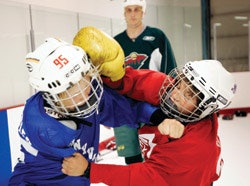
When asked why USA Hockey didn't take the next logical step and DQ fighting, as well, Stuart admitted that there is still resistance among those who adhere to the notion that fighting polices the game and is popular among a certain faction of fans. "People have even gone so far as to say that it sells tickets. I would never like to hear someone publicly state that we are promoting or allowing student-athletes to fight for financial gain, because it's truly not part of the game," says Stuart, who has watched three sons ascend to the NHL ranks. "I watch a lot of National Hockey League games, and if two weeks go by and I haven't seen a fight, I don't seem to miss it."
Cantu believes the NHL won't miss it, either. "The beauty of the NHL, in my opinion, is it can be proactive in a way that doesn't really change the sport dramatically," he says. "It's just taking headshots and fighting out of it, and the league has largely taken the headshots out, because you can be penalized now for purposely lining up somebody else's head and drilling it. The NHL has gone a long way, but it certainly hasn't done anything with regard to fighting."
Given its considerable pull within the hockey universe (according to Fischer, the only time USA Hockey saw its participation numbers decline since individual registration debuted in 1990 was following the NHL lockout season of 2004-05), the league could do a lot to set a more gentlemanly agenda for the sport at large.
For certain players, the pull is greater still. The Canadian Hockey League supplies the NHL with more than half its talent, and Don Hay, coach of the Vancouver Giants, likens playing - and fighting, if a player so chooses - in the CHL's Western Hockey League to an apprenticeship. "If the National Hockey League is going to take it out of their game, then we should take it out of ours, because there is no point to it," Hay told the Vancouver Sun in February. "We follow the lead of the NHL. If they have fighting, I don't think it's fair to our players to not have them exposed to it. The fighting aspect of their skill package could help them make a living at the next level."
It's exactly how Derek Boogaard made a living, before chronic traumatic encephalopathy likely contributed to his untimely death. How many players like Boogaard are out there, still skating and swinging away, remains unknown.
For now, Cantu's CTE warning shots are softened somewhat by the fact that science isn't close to being able to pinpoint the rate of incidence. But that still is no excuse for ducking the issue. "You can be on the proactive side or you can be on the side that says, 'Show me more data,' " Cantu says. "That's kind of where the NFL was coming from a few years back. I think the NHL is still kind of hanging on, saying, 'Show what the factors are that definitely cause one person to have CTE and the other one not,' as opposed to saying, 'It's out there, and it's out there in more than just a couple of people, so let's be proactive in every way that we can.' They kind of look the other way about something that's causing brain damage in some individuals. You have to be hypocritical if you're thinking you're protecting your athletes and you let this fighting go on."





















